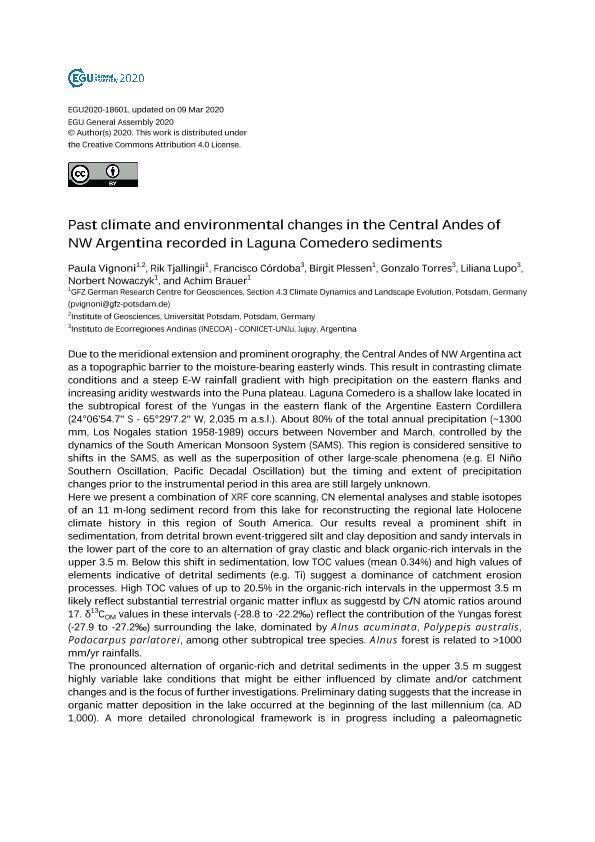Evento
Past climate and environmental changes in the Central Andes of NW Argentina recorded in Laguna Comedero sediments
Vignoni, Paula; Tjallingii, Rik; Cordoba, Francisco Elizalde ; Plessen, Birgit; Torres, Gonzalo Román
; Plessen, Birgit; Torres, Gonzalo Román ; Lupo, Liliana Concepcion
; Lupo, Liliana Concepcion ; Nowaczyk, Norbert; Brauer, Achim
; Nowaczyk, Norbert; Brauer, Achim
 ; Plessen, Birgit; Torres, Gonzalo Román
; Plessen, Birgit; Torres, Gonzalo Román ; Lupo, Liliana Concepcion
; Lupo, Liliana Concepcion ; Nowaczyk, Norbert; Brauer, Achim
; Nowaczyk, Norbert; Brauer, Achim
Tipo del evento:
Congreso
Nombre del evento:
EGU General Assembly 2020
Fecha del evento:
04/05/2020
Institución Organizadora:
European Geosciences Union;
Título del Libro:
EGU General Assembly 2020
Editorial:
European Geosciences Union
Idioma:
Inglés
Clasificación temática:
Resumen
Due to the meridional extension and prominent orography, the Central Andes of NW Argentina act as a topographic barrier to the moisture-bearing easterly winds. This result in contrasting climate conditions and a steep E-W rainfall gradient with high precipitation on the eastern flanks and increasing aridity westwards into the Puna plateau. Laguna Comedero is a shallow lake located in the subtropical forest of the Yungas in the eastern flank of the Argentine Eastern Cordillera (24°06´54.7" S - 65°29´7.2" W, 2,035 m a.s.l.). About 80% of the total annual precipitation (~1300 mm, Los Nogales station 1958-1989) occurs between November and March, controlled by the dynamics of the South American Monsoon System (SAMS). This region is considered sensitive to shifts in the SAMS, as well as the superposition of other large-scale phenomena (e.g. El Niño Southern Oscillation, Pacific Decadal Oscillation) but the timing and extent of precipitation changes prior to the instrumental period in this area are still largely unknown. Here we present a combination of XRF core scanning, CN elemental analyses and stable isotopes of an 11 m-long sediment record from this lake for reconstructing the regional late Holocene climate history in this region of South America. Our results reveal a prominent shift in sedimentation, from detrital brown event-triggered silt and clay deposition and sandy intervals in the lower part of the core to an alternation of gray clastic and black organic-rich intervals in the upper 3.5 m. Below this shift in sedimentation, low TOC values (mean 0.34%) and high values ofelements indicative of detrital sediments (e.g. Ti) suggest a dominance of catchment erosion processes. High TOC values of up to 20.5% in the organic-rich intervals in the uppermost 3.5 m likely reflect substantial terrestrial organic matter influx as suggested by C/N atomic ratios around 17. δ13COM values in these intervals (-28.8 to -22.2?) reflect the contribution of the Yungas forest (-27.9 to -27.2?) surrounding the lake, dominated by Alnus acuminata, Polypepis australis, Podocarpus parlatorei, among other subtropical tree species. Alnus forest is related to >1000 mm/yr rainfalls. The pronounced alternation of organic-rich and detrital sediments in the upper 3.5 m suggest highly variable lake conditions that might be either influenced by climate and/or catchment changes and is the focus of further investigations. Preliminary dating suggests that the increase in organic matter deposition in the lake occurred at the beginning of the last millennium (ca. AD 1,000). A more detailed chronological framework is in progress including a paleomagnetic reconstruction for this area.
Archivos asociados
Licencia
Identificadores
Colecciones
Eventos(INECOA)
Eventos de INSTITUTO DE ECORREGIONES ANDINAS
Eventos de INSTITUTO DE ECORREGIONES ANDINAS
Citación
Past climate and environmental changes in the Central Andes of NW Argentina recorded in Laguna Comedero sediments; EGU General Assembly 2020; Vienna; Austria; 2020; 1-2
Compartir
Altmétricas



